Kansas City Chiefs: Visual Breakdown and Analysis of Quarterback Geno Smith
The following breakdown will highlight Smith's dynamic skill set and display why the Chiefs should consider taking West Virginia's playmaker at No. 1 overall.
Smith's game will be broken down on five levels: pocket presence, arm strength, mechanics, accuracy and intangibles.
Pocket Presence
A quarterback's pocket presence unveils key attributes of his psyche. Does the player show poise and evade pressure while keeping his eyes downfield, or will he regress to a panicked frenzy and surrender in the fetal position?
Is the quarterback acutely aware of his surroundings, and is he known to manipulate the pocket to elude pressure? Or will he fall victim to tunnel vision and operate oblivious to the pass rushers?
When compared to his 2013 compadres, Smith's presence is second to none. He dictates the pocket, as opposed to letting a shrinking pocket dictate him (see Matt Cassel).

In the above highlight, West Virginia lines up in a trips-left formation (three wide receivers on the left side of the line), and Smith immediately scans the trio's half of the field once the ball is snapped. Seeing that his slot receiver is covered after running a hook route, he steps up through a crease in the right half of the pocket. However, his running back fails to diagnose and pick up the delayed blitzer, who freely charges at the quarterback like a crazed bull.
Even with one arm draped across his chest, Smith still manages to connect with a receiver for a nine-yard first down.
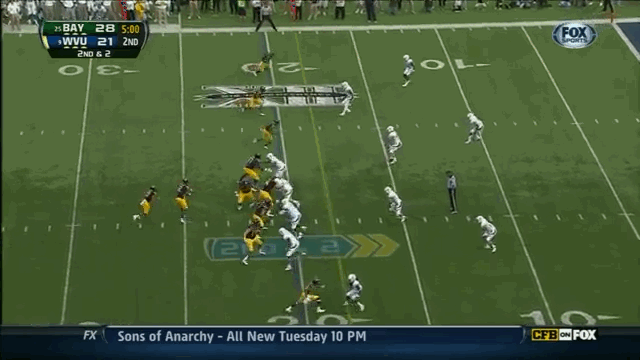
Here, West Virginia's left tackle is victimized by a rip move. Baylor's right defensive end barrels toward the quarterback, and Smith rolls to the right to negate the oncoming pressure. Eventually, he lobs a high-arcing pass to Stedman Bailey in the back of the end zone.
This is the kind of play that truly defines a quarterback as a playmaker, and only a select group of passers are capable of pulling it off.
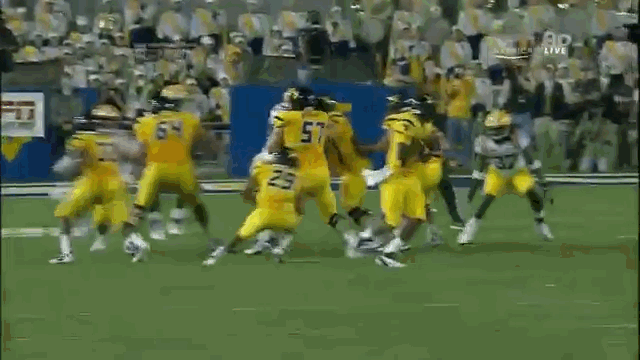
Again, the West Virginia tailback lags in recognizing the pursuer. Smith, with his eyes still locked downfield, steps up in the pocket to avoid the edge rusher. The LSU player's momentum carries him past the quarterback, but not before he attempts to swipe and drag No. 12 down by the hip. Smith spin-cycles out of the would-be-tackler's grasp, rolls right and throws a 10-yard strike across the field.
Arm Strength
In the NFL, a premium is placed on arm strength.
Quarterbacks attempt to sling passes through Boeing-like windows as defenders relentlessly shadow receivers; it's like playing laser tag in a room full of hyperactive cats.
Smith doesn't boast the strongest arm of the 2013 class. But, rest assured, he will answer the call and launch rockets when necessary.

As the play unfolds, Baylor rushes three and drops eight defenders into zone coverage.
In this scenario, Smith is presented with two logical options: throw a screen to his slot receiver—which would likely result in a minimal gain, considering the strongside linebacker is roaming the area—or bullet a pass between the two safeties and inside linebacker.
The second choice requires perfect timing and pinpoint accuracy in order to be successful; Smith provided both.
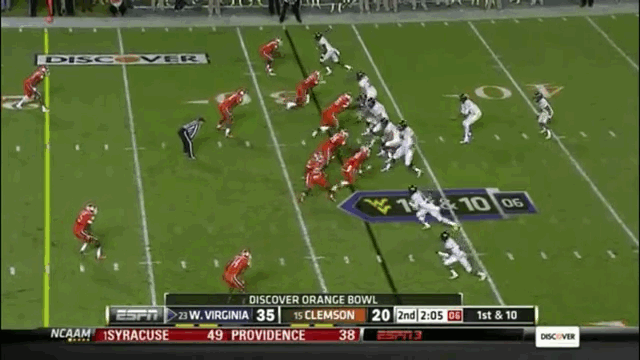
Clemson elects to rush defenders while a linebacker plays the "spy" role: He tracks the quarterback's line of vision and stalks his movement, limiting the passer's ability to scramble.
Smith subtly steps forward to avoid pressure and delivers a missile down the middle of the field.
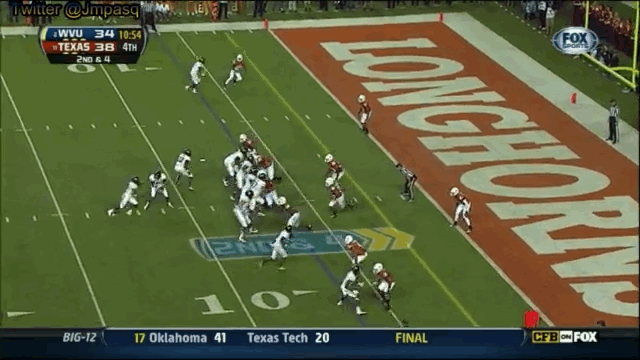
The play begins at the 6-yard line.
Play-action momentarily freezes the inside linebacker for Texas, creating a wider passing lane to the left side of the field. The safety overplays the receiver's route, resulting in Smith splitting the alley between the safety and inside linebacker.
Mechanics
Ideally, quarterbacks will drop back holding the football at shoulder-pad level. They should bend their knees when planting—while keeping a wide stance with their feet—guide the pass with their shoulders and feet perpendicular to the target, then release the ball with the throwing elbow above the shoulders.
At least, that would be conventional wisdom offered by a scout in a five-floor elevator ride.
Like many prospects, Smith's mechanics, while solid, could benefit from some tweaking at the next level.
Most scouts would likely claim that Smith, at times, doesn't hold the ball at a secure height, and his whipping throwing motion results in a less-than-desirable release point. Smith also has a tendency to swing his plant foot or throw off of it with rushers converging in front of him.
Regardless, whatever he's doing is obviously working, with potential to be even better.

The fluidity of this play mimics drills on Jon Gruden's quarterback specials.
Smith sells the run, makes a five-step drop and completes a comeback route across the field—one of the most difficult throws in football.

Working against the vaunted second-ranked defense of LSU, Smith points his shoulders in the direction of the outside receiver.
The fake forces the safety to drift toward the sideline and allows the West Virginia quarterback to gun a touchdown pass in the middle of the end zone.
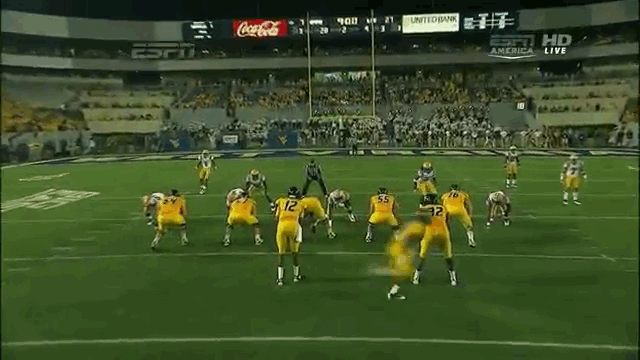
Smith already knows where he wants to go with the football on this play.
Following the snap, his legs stay aligned parallel to the hash marks, but he looks off the safety by eyeing his wideout on the left side of the formation. The safety bites—and even turns around—which gift-wraps an open field for West Virginia's tight end.
Accuracy
Accuracy: It's the most fundamentally significant aspect of passing, and it's also Geno Smith's biggest selling point.
In most cases, college statistics are irrelevant when projecting how talent will transition to the NFL. And ex-coaches wouldn't be labeled whistleblowers by revealing how fragile Big 12 defenses tend to be. And yes, West Virginia showcases a spread offense, which tends to inflate statistics.
But West Virginia doesn't call as many screens as most outsiders would presume. Plus, 39 of Smith's passes racked up at least 25 yards (via CFBstats.com). Smith's GPS-like accuracy (pause for critics to make an Apple Maps joke) and sound decision-making deserve the lion's share of credit for completing 71.2 percent of his passes and throwing 42 touchdowns to only six interceptions.
You're not going to find a quarterback with better ball placement. Period.

Short Passing: Operating from Texas' 7-yard line, the safety and weakside linebacker take the play-action bait, and Smith rifles a completion on a slant route.
If the pass spiraled off course to the right, it would have been batted in the air. If it faded farther to the left, the cornerback would have welcomed an interception with open arms. Had the throw lacked velocity, the receiver would have been nailed harder than a Tool Time blooper.
But Smith drilled it right in between Bailey's hands.

The books recorded this pass as a seven-yard touchdown. But technically, the throw traveled close to 18 yards in the air.

Red-zone fades are a true testament to how dynamic a passer is.
The art of quarterbacking strips down to one core principle: accuracy. And on a red-zone fade, all that a passer is asked to do is throw a finessed lob inside of the corner pylon. Simple enough, right?
But the quarterback can't put too much air under it, or the cornerback will jostle for position and intercept it. The thrower can't toss it with too much strength, or the ball will sail out of bounds. And while most fades target a tall wideout with springs for calves, Geno Smith is tasked with dropping it in to the 5'10" Stedman Bailey.
But Smith's accuracy allows him to execute the throw in textbook fashion.

In another goal-to-go scenario, West Virginia's playmaker lasers a pass to Bailey on a slant.
If his receiver doesn't come down with it, nobody does.

Intermediate Passing: Smith backpedals from Clemson's left defensive end, then rolls away from backside pressure.
On the move, he fires a 14-yard fastball to Tavon Austin.
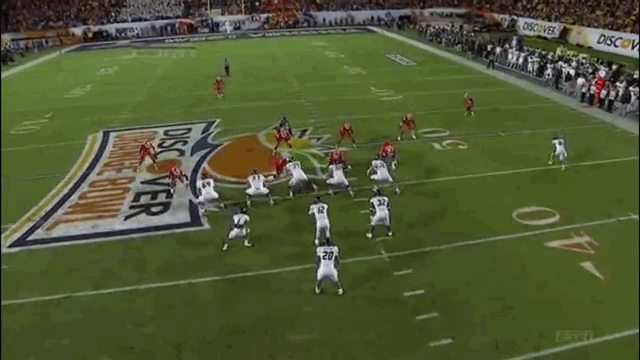
At the last second, Clemson's inside linebacker drops into coverage and obscures Smith's primary target.
Instead of risking an inaccurate throw, Smith refrains from the gamble, resets his feet and completes a 15-yard out route over a soaring linebacker on the opposite side of the field.
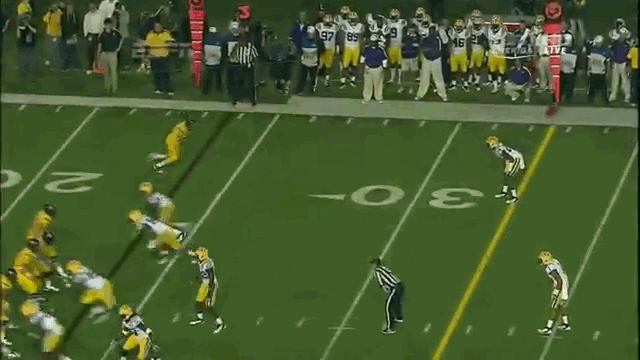
The above clip exhibits Smith's anticipation and timing. The pass oozes with confidence and speaks to the harmonious rapport that the quarterback shares with his receivers.
This particular completion is indicative of what to expect from the senior's game. Accuracy laid the foundation for his hype train, and leading his receivers has proven to be one of Smith's trademarks.
NFL fans will rarely witness a wideout slow to a halt in order to catch the ball, then turn upfield and chew up yardage like a rural mower. The speed of the game doesn't allow it.
Smith has developed a symbiotic relationship with his pass-catchers, hitting them in stride so they can capitalize on their momentum down the field.
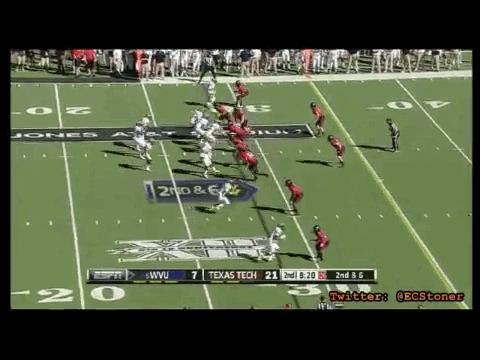
Downfield Passing: Sure, a smattering of West Virginia's 39 deep passes were attributed to the game-breaking elusiveness of Bailey and Austin. But the vast majority stemmed from aerial arches sponsored by Smith's right arm.
His most noticeable improvement from the 2011 season came in the form of downfield passing.
Good offense trumps good defense. In the above highlight, the Texas Tech cornerback and West Virginia's receiver are practically joined at the hip. If Smith doesn't deliver a flawless throw, the pass lands out of bounds, ricochets incomplete or sticks to the defender's gloves.
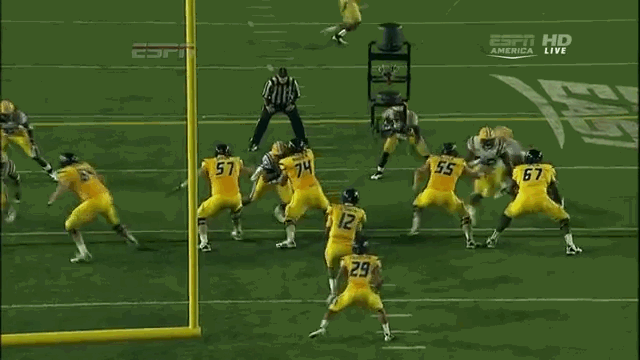
With his back against West Virginia's end zone, Smith torches LSU by catapulting a downfield bomb that strikes No. 1 in stride.
Being that Austin could run through the wilderness and spark a forest fire, that says something.
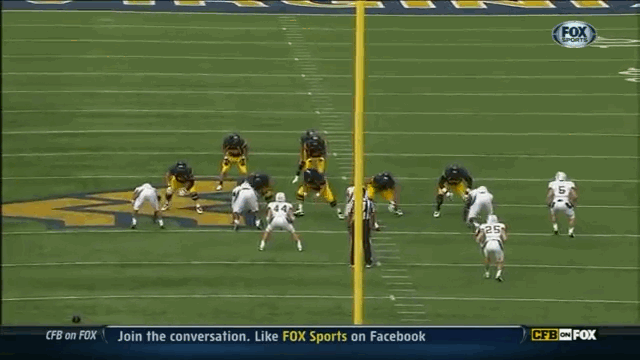
Despite eight defenders retreating into coverage, Smith evades Baylor's bull-rushing defensive tackle and draws a pigskin rainbow through the air.
Double coverage still failed, as Smith's Mountaineers eclipsed the 70-point mark following the touchdown.
Intangibles
Smith shows all the signs of a perfectionist: He's a highly competitive English major who studies more film than Roger Ebert.
West Virginia head coach Dana Holgorsen said (via ESPN),
There are a lot of guys who will sit and get on the Internet and read article after article about themselves, or turn on the TV and record their interviews. [Geno Smith's] a guy that just doesn't do that. He would rather read a book or put a [video] on his iPad and go home and study.
It shows on the field. Smith won't attempt to thread the needle if there's no purpose to it.

This is an unconventional play, but one that West Virginia utilizes from time to time.
It's a double screen: the slot receiver doesn't run a route at the snap but turns to Smith as other wideouts block up the field. Smith recognizes that the Baylor linebacker drops into zone and will be able to make a play on the slot wideout.
On the other side of the field, West Virginia's right guard and center release from their blocks, heading upfield to plow the way for their running back. But Smith sees that Baylor's left defensive end recognized the screen, as he runs stride-for-stride with the West Virginia tailback.
With nine defenders in coverage, Smith wastes no time in deciding to scramble with the ball—the only sensible option left.